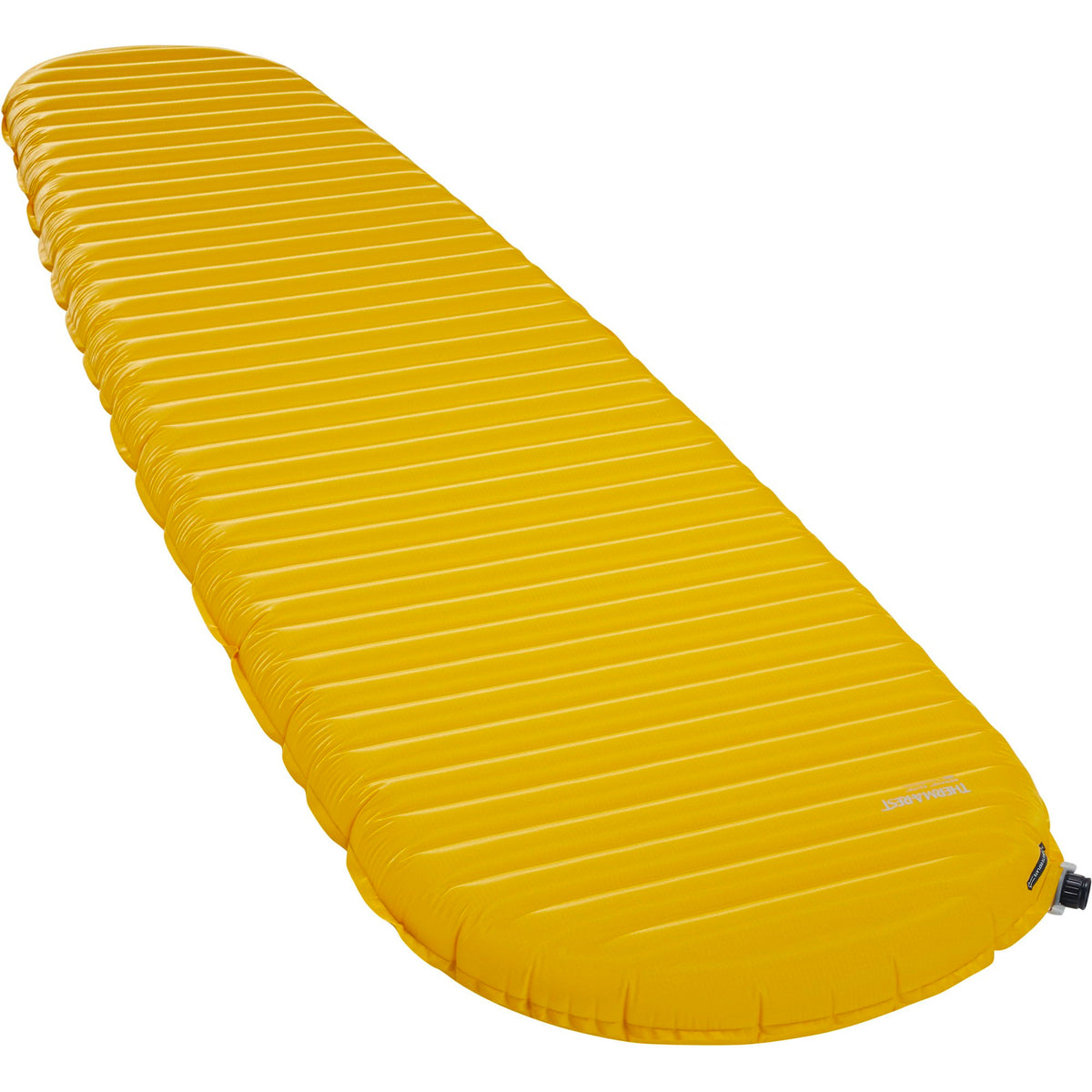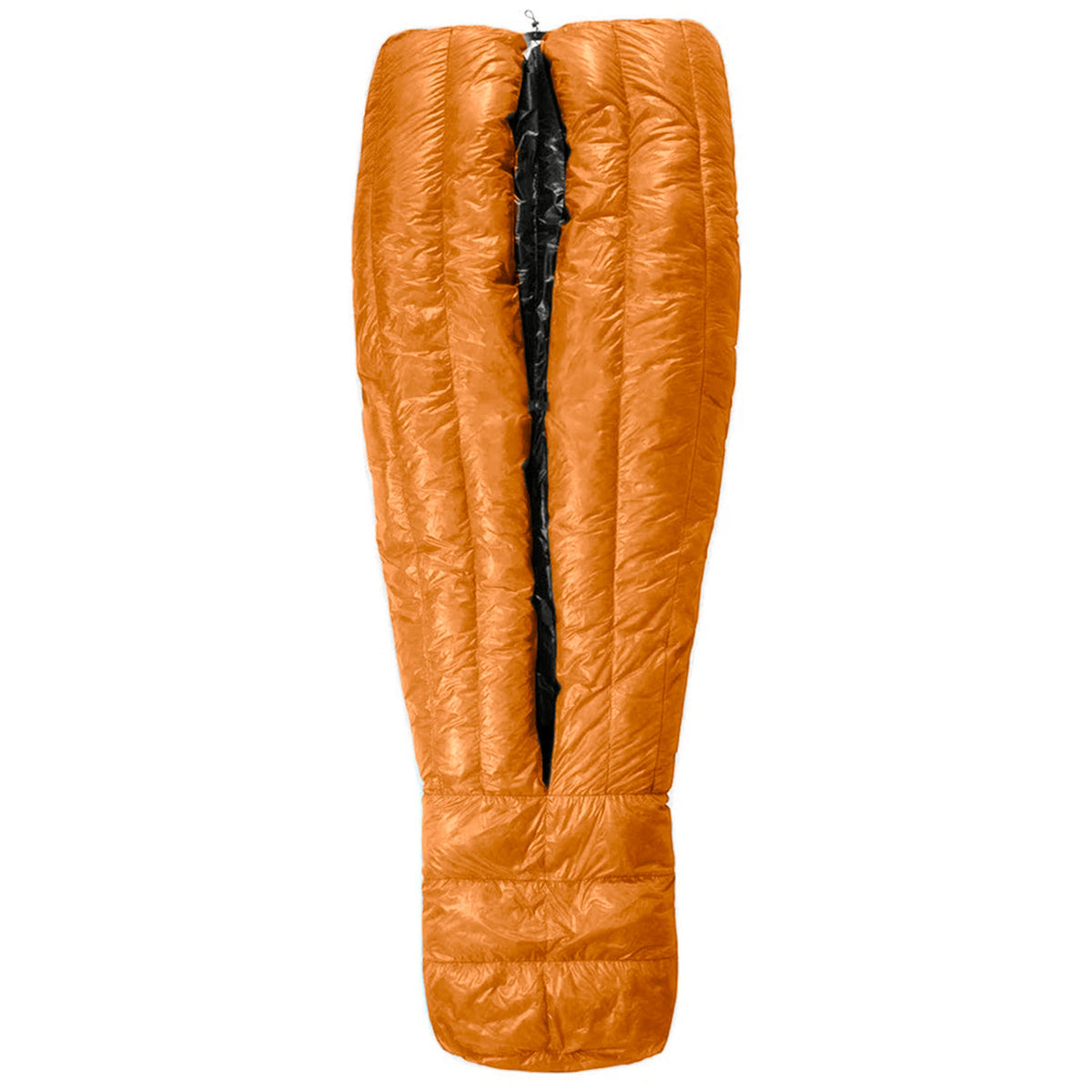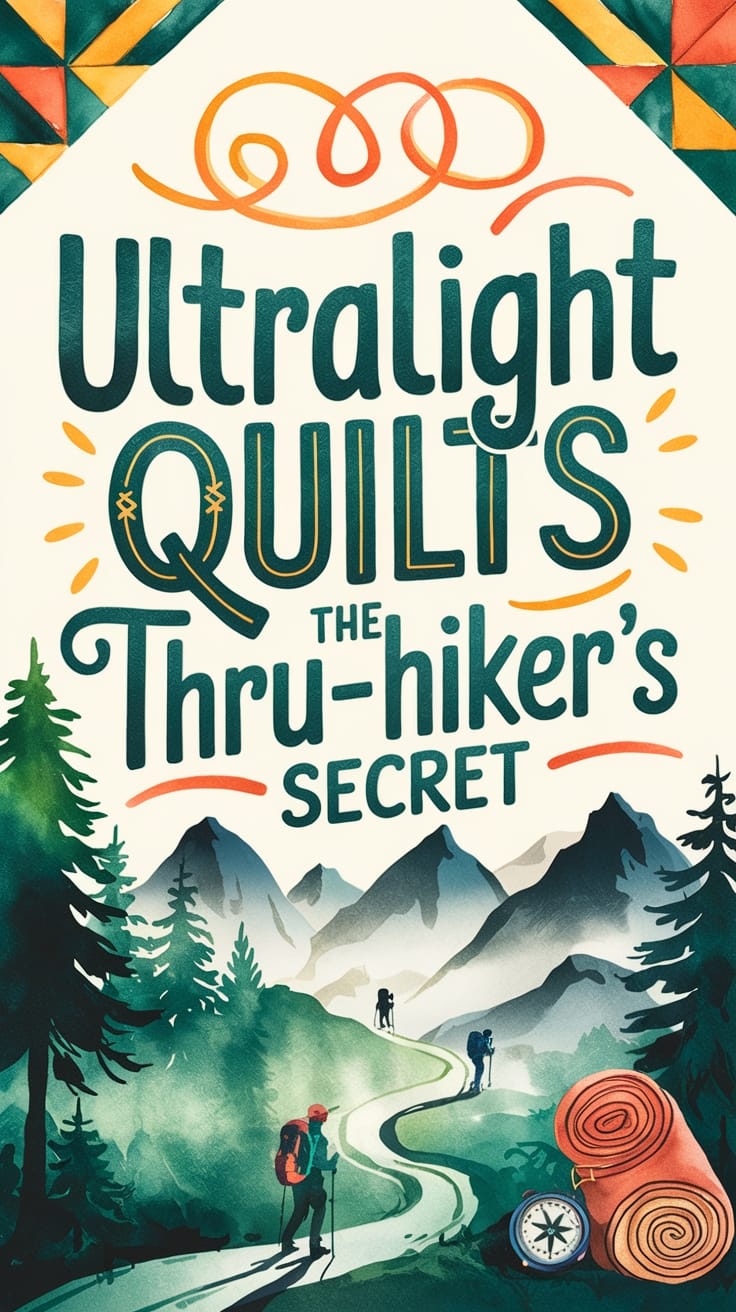When you're planning a thru-hike, your selection of sleep system can make or break your experience on the trail. You'll spend roughly a third of your journey tucked in your quilt, so choosing the right one isn't just about comfort—it's about survival and sustainable energy management.
Let's explore how you can identify the perfect quilt that'll keep you cozy without weighing down your pack.
Your Thru-Hiking Quilt Survival Guide
- Consider temperature ratings and add 10 degrees for real-world performance, ensuring the quilt matches your planned hiking season and climate.
- Choose between down fill for better warmth-to-weight ratio or synthetic fill for wet conditions and easier maintenance.
- Select proper dimensions by adding 4-6 inches to your height and ensuring adequate width based on your sleeping style.
- Look for essential features like draft collars, neck cinch systems, and adjustable footboxes to prevent heat loss.
- Match your budget with different options, from affordable Hammock Gear Burrow to premium Katabatic Gear or Zpacks quilts.
Decoding Quilt Temperature Ratings for Trail Success

The mysterious world of quilt temperature ratings isn't as clear-cut as you might think. While manufacturers like Zpacks and Enlightened Equipment use sophisticated testing methods with heated manikins, these ratings often represent ideal conditions that you won't always encounter on the trail.
Many users have found their quilts perform effectively within 10 degrees of the stated rating.
What works perfectly in a controlled testing environment might feel quite different when you're camping at 10,000 feet amidst an unexpected cold snap. Down quilts provide excellent longevity compared to synthetic options when properly maintained.
Environmental conditions, such as humidity and radiational cooling, can dramatically impact your quilt's performance, especially at higher elevations or in northern regions.
Don't forget that your quilt is just one part of a complete sleep system. You'll want to pair it with a high R-value sleeping pad (think 4.0 or higher for cold weather), and take into account how you'll use additional layers like puffy jackets or base layers to maximize warmth when temperatures drop below your comfort zone.

Trail Tested: Quilts or Sleeping Bags?

When choosing between a quilt and sleeping bag, you'll need to weigh the distinctive benefits each choice brings to your thru-hiking journey.
Quilts offer compelling advantages, being 20-30% lighter than comparable sleeping bags and taking up notably less pack space, which you'll appreciate in long-distance hikes.
Modern quilts also feature versatile footbox options that adapt to different temperature needs. They're also perfect if you're a restless sleeper, offering unrestricted movement without the constraints of zippers or hoods. Both down and synthetic fill options are available to match your specific needs.
While quilts dominate spring through fall hiking, sleeping bags reign supreme in winter conditions where extensive insulation is essential.
Recent trends show quilts gaining popularity, with 56+% of Appalachian Trail hikers now preferring them over traditional sleeping bags.
The satisfaction rates tell an interesting story too - only 6% of quilt users report dissatisfaction, compared to 12% of sleeping bag users.
If you're focused on ultralight backpacking in three-season conditions, a quilt's weight savings and versatility make it an excellent choice for your thru-hiking adventures.

Choosing Your Quilt's Core: Down vs. Synthetic

Choosing between down and synthetic fill remains one of backpacking's most consequential decisions.
High-quality down insulation can provide exceptional longevity with proper maintenance. You'll especially appreciate down's superior compressibility when you're trying to squeeze everything into your backpack for a months-long adventure. Down fill power typically ranges from 450 to 1000, with higher numbers indicating better insulating properties at less weight penalty and better compressability.
Nonetheless, synthetic fill might be your better choice if you're hiking in perpetually wet conditions, like the Pacific Northwest's notorious rainfall.
While down becomes practically useless when soaked, a synthetic insulation continues performing admirably even in consistently damp conditions, maintaining its warmth and drying considerably faster.
You'll also find synthetic quilts easier on your wallet and simpler to maintain, though they'll typically weigh more and pack larger than their down counterparts.
If you're tackling the dry conditions of the Arizona Trail, down's exceptional warmth-to-weight ratio makes it the obvious winner. For the consistently wet Appalachian Trail, on the other hand, synthetic's moisture resistance might prove invaluable, especially in those inevitable multi-day rainstorms.
Cutting Ounces: The Weight-Comfort Balancing Act

Beyond fill type, a quilt's weight and packability can make or break your thru-hiking experience.
You'll find that quilts offer outstanding weight savings compared to sleeping bags, with models like the Zpacks Solo Quilt weighing 40+% less than their Mummy Sleeping Bag counterpart.
When you're logging serious miles, every ounce counts, and ultralight alternatives like the Zpacks Solo Quilt, at just 16.2 ounces for a 20°F rating, can make a noticeable difference in your pack weight.
As seen with the dangerous situation of carrying 150 pounds of gear on Mt. Whitney, keeping your load ultralight is crucial for safety and enjoyment. Synthetic insulation remains a reliable choice for wet conditions, though it typically weighs more than down.

Always Check Bargain Bins On Websites For Huge Savings!
What's even better is how efficiently quilts compress and pack down. Without a hood and full back, you'll find they're incredibly versatile when it comes to stuffing them into your pack.
You don't even need a stuff sack - just use your quilt to fill around or behind heavier items, and it'll compress naturally.
To maximize both weight savings and warmth, look for quilts with higher down fill amounts, like the UGQ Bandit, which allows for easy request for overfill ounces of down than other off the shelf quilt or sleeping bags.
Think about customizable features like adjustable straps and shock cords, but keep in mind that each added feature means a slight weight penalty.
Must-Have Features for Trail-Ready Quilts
The right features on your quilt can make up for the lack of a traditional sleeping bag's full enclosure. You'll want to focus on a draft collar and neck cinch system that prevents precious warmth from escaping, while the differential cut design maximizes your down's loft potential.
Side elastic systems developed by innovative manufacturers like Warbonnet have revolutionized draft prevention in modern quilts.
For supreme versatility, think about a zippered footbox that lets you fully open the quilt on warmer nights or zip it up tight when temperatures drop. According to surveys, 56% of thru-hikers now choose quilts over traditional sleeping bags.

When it comes to staying cozy, you'll find horizontal baffles are your best friend, allowing you to shift down where you need it most while preventing unwanted migration.
The attachment system is essential - look for continuous pad straps that'll keep your quilt snugly secured to your sleeping pad, eliminating those dreaded drafts.
Don't overlook the importance of fabric choice; a 10D DWR-treated nylon offers an excellent balance of durability and a 7D offers tremendous weight savings, while water-resistant down (such as treated 850- or 950-fill) provides peace of mind in damp conditions.
For extra protection against the cold, you might want to think about custom overfill options or internal pockets that keep your electronics and essentials toasty.
Finding Your Perfect Quilt Fit: Size Matters
Success on the trail starts with proper quilt sizing, where a well-fitted quilt can make the difference between cozy nights and shivering sleeps.
When determining your ideal quilt length, you'll want to add 4-6 inches to your height to guarantee proper coverage, though taller hikers should lean toward the upper end of this range. This extra length lets you tuck the quilt around your neck and accounts for natural contouring around your body.
For width assessments, measure your shoulder girth at its widest point and add 6-10 inches for peak coverage.
If you're a side sleeper who tosses and turns, you'll definitely want to choose a wider quilt, while back sleepers can usually get away with something narrower.
Don't underthink on the footbox choice, especially if you've got larger feet - you'll want enough room to prevent compression while keeping drafts at bay.
Keeping Your Quilt Trail-Ready: Maintenance Essentials
Once you've found your perfectly sized quilt, proper care will extend its lifespan and maintain its warmth-giving properties for years to come.
To keep your quilt in top condition, you'll need to wash it at least annually, especially after completing a long-distance hike when dirt and oils have accumulated in the down.
When it's time to clean your quilt, turn it inside out and use specialized products like Nikwax Down Wash or ReviveX Down Cleaner Concentrate, which preserve the down's natural oils.
Don't be tempted to use regular detergent or fabric softener, as these can damage your quilt's precious insulation. Throughout the washing process, you'll want to thoroughly rinse the quilt for at least 30 minutes, using multiple rinse cycles to verify all soap residue is removed.
Drying requires patience and attention - your quilt's worst enemy is rushed drying that leaves damp spots behind.
Use tennis balls or dryer balls on a low heat setting to restore loft, and don't forget to break up any clumps between cycles.
For storage, keep your quilt uncompressed and completely dry to prevent unwanted visitors like mold and mildew.
Top Quilt Brands: Performance Meets Your Budget
When you're ready to explore thru-hiking quilts, you'll find remarkable alternatives across every price point, from Hammock Gear's wallet-friendly Burrow 20 at $284 to Western Mountaineering's premium AstraLite at $500.
The mid-range sweet spot includes trusted favorites like Enlightened Equipment's Revelation 20 starting around $345, which offers an excellent balance of quality and affordability for most thru-hikers.
Whether you're watching your budget or seeking the absolute pinnacle of performance, today's market features impressive selections from established manufacturers like Katabatic Gear, Zpacks, and UGQ, each bringing their unique strengths to temperature ratings, weight savings, and customization alternatives.
Invest in Comfort: Premium Quilts for Serious Hikers
Investing in a premium cottage thru-hiking quilt can set you back over $500+, but the enhanced durability, superior warmth-to-weight ratio, and advanced features make them worth contemplating.
At the high end, you'll find exceptional alternatives like the TrailHeadz 1000FP Ethereal Down Top Quilt, which delivers impressive 1000 fill down in a svelte 19-ounce package, and Hyperlite Mountain Gear's 20 Degree Quilt, boasting ultra-premium 1000 fill power down also.
For remarkable value, the ever reliable trail loved quilt, the EE Revelation, which provides customizable temperature ratings from 0 to 50 degrees and high-quality 850-950 fill down at a more accessible price point of $345-365.
If you're focused on minimizing weight, Zpacks' Solo Quilt 20 shines with its featherlight 13.6-ounce configuration and innovative 7D Ventum ripstop nylon construction.
Make sure not to overlook Katabatic's exceptoional quilts, especially the Alsek 22, which features an ingenious pad attachment system that'll keep you snug through the night.
Trail-Worthy Quilts That Won't Break the Bank
Smart thru-hikers don't need to break the bank to get a quality sleeping quilt. Several manufacturers offer impressive budget-friendly choices that deliver exceptional value without compromising essential features.
The UGQ Bandit, priced around $260 for a 20-degree version, differentiates itself with its impressive customization options and competitive weight, making it a top choice for cost-conscious backpackers who don't want to sacrifice quality.
If you're looking to save even more, the Hammock Gear Burrow presents an excellent alternative, and it often goes on sale with discounts up to 30%. While it's slightly heavier than the Bandit, the quality-to-price ratio is outstanding.
For those seeking the absolute best deal, the Featherstone Moondance 25 comes in at just $229, though you'll carry a bit more weight for the savings.
REI's Magma Trail Quilt 30, while pricier at $329, becomes an attractive option when you factor in member discounts and REI's legendary return policy.
These quilts prove that you don't have to spend a fortune to stay warm and comfortable on the trail.
Quilt Brands Showdown: Which Reigns Supreme?
The scenery of premium quilt manufacturers offers distinct advantages for thru-hikers seeking top-tier performance.
You'll find industry leaders like Katabatic Gear and Western Mountaineering delivering exceptional warmth-to-weight ratios, while maintaining impressive durability that'll serve you well on long trails.
When you're comparing top brands, you'll notice Katabatic differentiates itself with its precise temperature ratings and innovative horizontal baffle design, while Enlightened Equipment quilts offer simple customization options, though you'll need to plan ahead for their eight-week lead time.
If you're focused on ultralightweight gear, Zpacks' Solo Quilt 20 deserves your attention with its remarkable 16.2-ounce weight and 900-fill power down.
Meanwhile, Hyperlite Mountain Gear's quilts feature premium 1000-fill power down and clever design elements like shifting baffles, making them especially suitable for demanding thru-hikes where every ounce counts.










